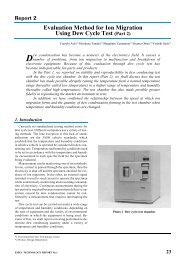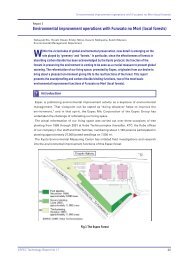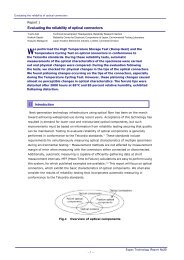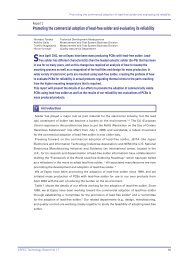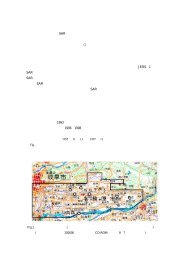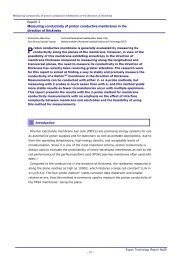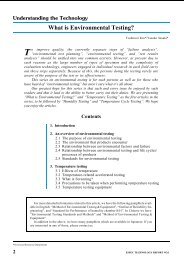download
download
download
You also want an ePaper? Increase the reach of your titles
YUMPU automatically turns print PDFs into web optimized ePapers that Google loves.
Measuring Conductivity of Proton Conductive Membrane in the direction of thickness, partⅡ:<br />
using the 4-probe method in the direction of thickness<br />
1<br />
Introduction<br />
Compared to measuring in the in-plane direction, the 4-probe method of measuring in the<br />
direction of thickness features a much smaller cell constant (L/A in σ=L/(RA))because the<br />
membrane is thinner and possesses a larger area. Consequently, the measured resistance,<br />
typically within the range of 0.1 to 50Ω, is significantly lower than that in the in-plane direction<br />
when using the 4-probe method, in which resistance can be as high as 10 to 10 4 Ω according to<br />
the temperature and humidity environments used. When measuring in the direction of thickness<br />
with the 4-probe method, some new problems may hinder widespread practical application.<br />
(1) Dispersion in measurement values may be incurred by unevenness of interlayers in<br />
membrane laminates and/or contact between the reference electrode and its adjacent<br />
membranes. Such dispersion may also be induced by the MEA (membrane/electrode<br />
assembly) from the much thicker wire diameter of the reference electrodes.<br />
(2) A much larger contact area between the reference electrode (which samples electric potential<br />
on one face of the test membrane) and the test membrane, which may come from the<br />
exfoliation and/or the crumbling of the coating layer on the reference electrode, will<br />
(a) produce rather larger interface resistance than bulk test membrane and smaller interface<br />
capacitance between the test membrane and the reference electrodes. With these<br />
influences, some labile arc-like loops and/or semi-circles may arise in the Cole-Cole plot,<br />
which will make it impossible for the 4-probe method to avoid being influenced by effects<br />
related to interfaces.<br />
(b) cause the hemi-circles on the Cole-Cole plot to be unsteady due to changes in the contact<br />
area between the reference electrodes and membrane, and to be susceptible to the<br />
fluctuations of the temperature and the humidity in the operating environment.<br />
Furthermore, this mutability makes it impossible to measure bulk resistance of the<br />
membrane by intercepting on a real axis such as is done in 2-probe method.<br />
(3) When MEA specimens are produced at higher temperatures and pressures using<br />
hot-pressing, reference electrodes frequently break off from the wires sandwiched between<br />
test membranes and current lead-in membranes, causing functional failure. This is caused by<br />
the creep property of the polymeric membranes that are liable to stretch and deform.<br />
- 2 -<br />
Espec Technology Report No.23



